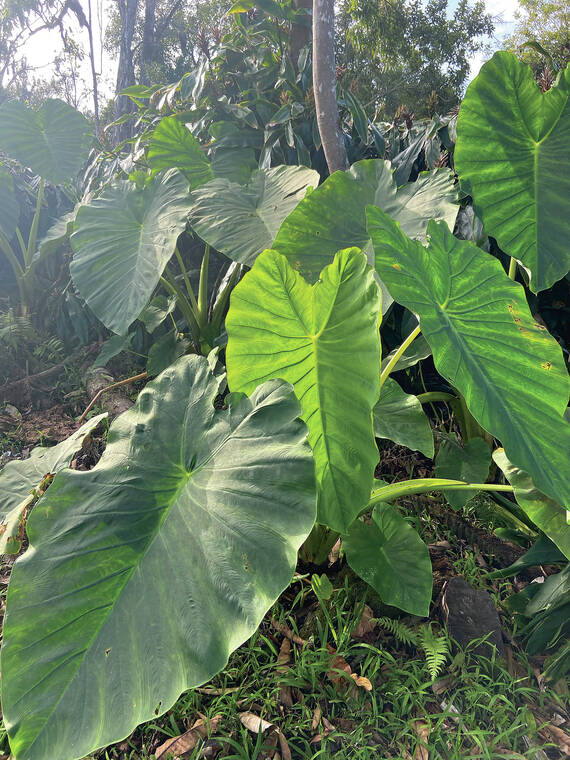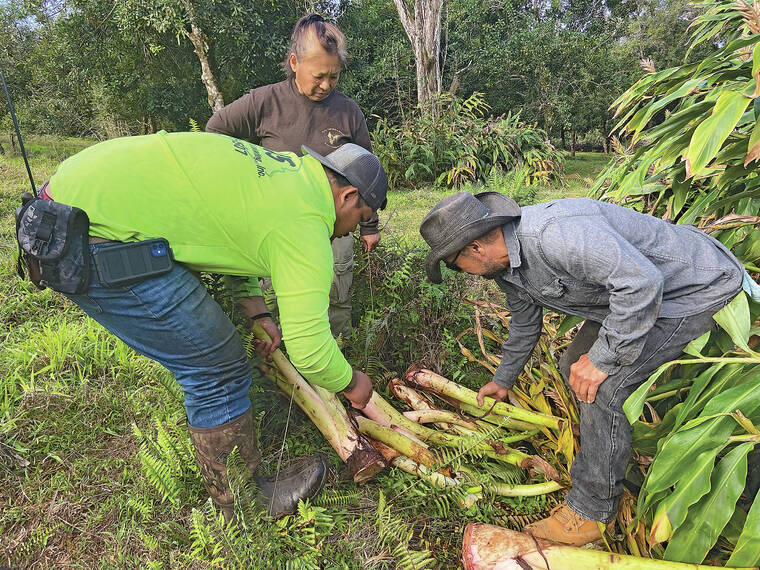Kalo nui: Kona couple unearths corm weighing nearly 50 pounds
A 50-pound kalo corm was harvested at Aina ‘Ahiu Farm in South Kona last month, making it possibly the largest taro ever recorded.
Clarence and Nellie Medeiros, who harvested the taro root, took the corm to be certified and witnessed at the Hawaii Ulu Producers Co-op, where it weighed in at a whooping 50 pounds. Taro usually weighs between 1 and 2 pounds, according to the U.S. Department of Agriculture.
The taro had been in the ground for 15 months on a patch of dry land at 1,600 feet elevation until it was ready to be harvested in late February. Nellie and Clarence the pulled it out of the ground on Presidents’ Day, Feb. 21, and are submitting the corm for the Guinness World Record.
The whole plant — including corm, stalk and leaves — weighed around 100 pounds, with eight keiki plants attached. The leaves reached about 9 feet, and 8 inches, from the ground.
In all, the couple estimated the taro could feed a party the size of 180 people and produce around 45 pounds of poi.
The taro harvested Feb. 20 is about seven times the size of the current Heaviest Taro Guinness World Record-holder, a 7.03-pound corm grown in 2009 in Minyang, Fuding City, located in Fujian province in China.
A taro corm unearthed in 2016 by Ke Kipi Kalo project in East Hawaii weighed in a 17.73 pounds was submitted to Guinness, but was never named the world record.
The Medeiros’s secret ingredient? Black dirt.
“We plant according to our land,” Clarence said. “We have pockets of dirt. Where we find the black dirt that’s where we plant it.”
The Medeiros’s also rely on nature and good luck.
“We have faith in nature that nature is going to take care. We do it with good intentions,” Nellie said.
Clarence was just 5 years old when he helped harvest his first taro. Working today on his family farm, Clarence still remembers carrying the taro down the mountain. If it was raining, the tropical plants’ rough outer shell would scrape his back, making the trek a dangerous endeavor.
Before the days of ATVs and four-wheelers, Clarence and his siblings (four of them) walked up and down the mountain to harvest a collection of crops — from coffee beans to ginger, avocados and mangos, lemons, macadamia nuts and oranges.
“This was manual labor, it was hard work,” Clarence said as he guided his ATV through the South Kona forest. Vastly different from downtown Kailua-Kona, South Kona is a wet, lush land that makes harvesting conditions— for plants like taro—prime growing conditions.
Clarence calls it his “wild land” or Aina ‘Ahiu. There are over 2,000 macadamia nut trees, along with wild ginger, which smells sweet in the springtime, when the rains are heavy.
“I use the wild things in combination with farming,” Clarence said.
But the main crop is taro. The entire taro plant can be eaten, not just the root, in a variety of Hawaiian dishes from the staple poi to lau lau and squid luau, both of which include taro leaves. And when the taro has been harvested, the bottom of the plant — the huli— can be replanted over and over again to create another generation of taro to feed the future.
Some of Clarence and Nellie’s favorite taro varieties include: ’o’opuka, mana ‘ele’ele, mana ke’oke’o, mana ‘opelu, mana ‘ulu, makoko, lehua and palai’i.
Clarence learned his farming techniques from his father and grandfather, but what really carried on was a sense of duty or responsibility, kuleana.
“We are doing it with a purpose and to keep it going for generations. We have our grandson who comes to help. Our grandsons are putting the Huli back. It comes full circle. Different generations feeding the next generations,” Clarence said.
Clarence’s grandson, Jamison, agreed.
“You can’t teach this stuff in school,” he said. “We grow taro out of love and it’s just how we were raised.
“The land provides for you so you don’t just want to take from the land and not put it back. It’s out of love and respect,” he continued.




